Optimizing Tunable LC Devices with Twisted Light
Abstract
:1. Introduction
2. Liquid Crystal Circular Devices
2.1. Liquid Crystal Lenses
2.1.1. Graded Index Lenses
2.1.2. Designing LC Lenses
- Zonal or pixelated lenses generate the quadratic index profile through independent electrodes. SLMs can be used to make such lenses; however, it is usual to employ pixels shaped as concentric rings [27].
- Modal lenses can produce smooth profiles without pixelization, with just one continuous electrode or a few of them at most. The electric field distribution—hence the index profile—is achieved by employing high-resistivity electrodes, usually between 100’s □ and some □. High-resistivity electrodes can be made of several materials, such as poly(3,4-ethylenedioxythiophene) polystyrene sulfonate (PEDOT-PSS) [28] or ultrathin indium–tin oxide (ITO) [29].
- The high-resistivity electrode behaves as a transmission line [30], and the profile can be modified by varying the voltage amplitude and the frequency, therefore making it possible to create radial voltage gradients that follow up the required quadratic index profiles for lenses or other profiles for different optical elements, e.g., axicons. Modal control has also been proposed in the Fresnel lens [31], which will be commented on below.
- A rather different approach is given by Pancharatnam–Berry phase devices (PPD, [35]), specifically Pancharatnam–Berry lenses. PPDs are elements in which electromagnetic waves undergo continuous phase changes due to a continuous change in the material through which they are passing. Typically, liquid crystal PPDs work by smooth variations of the alignment directions on both the confining surfaces of a retardation liquid crystal cell, i.e., introducing a fixed linear retardation with variable azimuthal angle.
2.1.3. Increasing LC Lens Power
- Use of high-birefringence LCs [42]. This can be helpful, but it is not a solution by itself. At present, high-BR mixtures are in the range of 0.4–0.5, which would double or triple the lens power at most.
- Increase of the cell thickness. LC cell thicknesses above 100 µm driven by ultrasounds have been proposed [43]. For electrically driven cells, however, thickness is severely restricted—usually to 20–30 µm—by response-time degradation and poor material orientation in thick cells. Again, alternative solutions, including dual-frequency nematics [44] and polymerization [45], have been proposed so that the spatial orientation of LC molecules is kept and the response time is improved.
- Decrease of the cell radius. This would alleviate the strong dependence that thwarts the lens power. A diopters lens of 1 cm diameter, like the above glass lens, would require an LC thickness of 314 µm, which would be impossible to control or orient with standard fabrication procedures. (Unsurprisingly, this is the thickness difference required for the glass lens, where its refractive index is 1.2 rather than 1.5, i.e., ). If the LC lens diameter is set to 2 mm, then the required LC thickness is 12.5 µm, a perfectly feasible value. Many groups work on LC microlens arrays [46,47] to take advantage of small diameters while keeping reasonable apertures.
- Creation of Fresnel lenses. Fresnel geometry provides the most powerful solution, capable of producing high-power, high-aperture lenses [48] with outstanding fill factor and excellent time response. This topic is dealt with in the next sections.
2.2. Fresnel Lenses
2.2.1. Types of Fresnel Lenses
2.2.2. LC Fresnel Lenses
2.3. Axicons
2.4. Vortices
2.4.1. Orbital Angular Momentum and Topological Charge
2.4.2. Liquid Crystal Vortices
2.4.3. Perfect Vortex Beams
2.5. Q-Plates
2.5.1. Half-Wave Retardations on Circular Light
2.5.2. PPDs and Q-Plates
2.5.3. Limitations of Q-Plates
3. Polarization-Independent Devices: Blue Phases
3.1. Orientation of BPs
3.1.1. Kossel Patterns
3.1.2. Conventional Alignment
3.1.3. Advanced Alignments
3.2. Thermal Stabilization
3.3. Applications of BPs
4. Spirals
4.1. Geometrical Spirals
4.2. Experimental Implementations
4.2.1. Interleaving
4.2.2. Electrical Connections
4.3. Spirals as Alternative Approach
- Design a 12-pie slice spiral phase plate (Figure 19, bottom center) with external electric connections.
- Twist the SPP five turns.
4.3.1. Design of Spiral Lenses and Axicons
4.3.2. Fill Factor
4.4. Tunability of Spiral Lenses
4.4.1. Assembling Spiral Lenses
4.4.2. Tunable SDLs
4.4.3. Analog vs. Digital SDLs
4.4.4. Obtaining True Fresnel Lenses
- By superimposing on the SDL an SPP with the same topological charge but opposite sign, the topological charges cancel out, and the result is equivalent to a classical Fresnel lens of the same power.
- The topological charge can also be canceled by using two identical lenses with an inverse topological charge. It is achieved by building a device made up of two units of the same lens coupled back-to-back. The topological cancelation is identical to the previous case, but the power of the resulting lens is twice the power of the individual lenses.
4.4.5. Experimental Verification
5. Conclusions
Author Contributions
Funding
Data Availability Statement
Conflicts of Interest
References
- Singh, A. Liquid Crystal Spatial Light Modulators. Available online: https://www.slideshare.net/azadajay/liquid-crystal-slms (accessed on 13 May 2023).
- Pinho, C.; Alimi, I.; Lima, M.; Monteiro, P.; Teixeira, A. Spatial Light Modulation as a Flexible Platform for Optical Systems. In Telecommunications Systems—Principles and Applications of Wireless-Optical Technologies; Alimi, I.A., Monteiro, P.P., Teixeira, A.L., Eds.; IntechOpen: Rijeka, Croatia, 2021; ISBN 978-1-78984-294-4. [Google Scholar] [CrossRef]
- Drăgulinescu, A. Optical Correlators for Cryptosystems and Image Recognition: A Review. Sensors 2023, 23, 907. [Google Scholar] [CrossRef] [PubMed]
- Chou, H.-H.; Chen, C.-L. Asymmetric Optical Wavelength Switch Based on LCoS-SLM for Edge Node of Optical Access Network. IEEE Photon-J. 2021, 13, 1. [Google Scholar] [CrossRef]
- Ma, Y.; Stewart, L.; Armstrong, J.; Clarke, I.G.; Baxter, G.W. Recent Progress of Wavelength Selective Switch. J. Light. Technol. 2021, 39, 896. [Google Scholar] [CrossRef]
- Lee, B.; Kim, D.; Lee, S.; Chen, C. High-contrast, speckle-free, true 3D holography via binary CGH optimization. Sci. Rep. 2022, 12, 2811. [Google Scholar] [CrossRef] [PubMed]
- Lingel, C.; Haist, T.; Osten, W. Spatial-light-modulator-based adaptive optical system for the use of multiple phase retrieval methods. Appl. Opt. 2016, 55, 10329. [Google Scholar] [CrossRef] [PubMed]
- Wu, Q.; Sui, X.; Fei, Y.; Xu, C.; Liu, J.; Gu, G.; Chen, Q. Multi-layer optical Fourier neural network based on the convolution theorem. AIP Adv. 2021, 11, 055012. [Google Scholar] [CrossRef]
- Dean, J. How Spatial Light Modulators Speed Optical Computing Applications. 2018. Available online: https://www.playbuzz.com/podrobnostiua10/10-20-2016-11-22-25-am10 (accessed on 13 June 2023).
- Wu, J.; Lin, X.; Guo, Y.; Liu, J.; Fang, L.; Jiao, S.; Dai, Q. Analog Optical Computing for Artificial Intelligence. Engineering 2022, 10, 133. [Google Scholar] [CrossRef]
- Davis, J.A.; Hall, T.I.; Moreno, I.; Sorger, J.P.; Cottrell, D.M. Programmable Zoom Lens System with Two Spatial Light Modulators: Limits Imposed by the Spatial Resolution. Appl. Sci. 2018, 8, 1006. [Google Scholar] [CrossRef]
- Caputo, R.; De Luca, A.; Strangi, G.; Bartolino, R.; Umeton, C.; De Sio, L.; Veltri, A.; Serak, S.; Tabiryan, N. The POLICRYPS liquid-crystalline structure for optical applications. Adv. Opt. Technol. 2018, 7, 273. [Google Scholar] [CrossRef]
- de Blas, M.G.; García, J.P.; Andreu, S.V.; Arregui, X.Q.; Caño-García, M.; Geday, M.A. High resolution 2D beam steerer made from cascaded 1D liquid crystal phase gratings. Sci. Rep. 2022, 12, 5145. [Google Scholar] [CrossRef]
- Paschotta, R. Axicons. RP Photonics Encyclopedia. Available online: https://www.rp-photonics.com/axicons.html (accessed on 8 June 2023). [CrossRef]
- Lee, D.; Lee, H.; Migara, L.K.; Kwak, K.; Panov, V.P.; Song, J. Widely Tunable Optical Vortex Array Generator Based on Grid Patterned Liquid Crystal Cell. Adv. Opt. Mater. 2021, 9, 2001604. [Google Scholar] [CrossRef]
- Gomez, M.A.; Snow, J.C. How to construct liquid-crystal spectacles to control vision of real-world objects and environments. Behav. Res. Methods 2023, 2. [Google Scholar] [CrossRef] [PubMed]
- Bailey, J.; Morgan, P.B.; Gleeson, H.F.; Jones, J.C. Switchable Liquid Crystal Contact Lenses for the Correction of Presbyopia. Crystals 2018, 8, 29. [Google Scholar] [CrossRef]
- Lee, S.; Park, G.; Kim, S.; Ryu, Y.; Yoon, J.W.; Hwang, H.S.; Song, I.S.; Lee, C.S.; Song, S.H. Geometric-phase intraocular lenses with multifocality. Light. Sci. Appl. 2022, 11, 320. [Google Scholar] [CrossRef] [PubMed]
- Zhang, X.; Cao, Z.; Mu, Q.; Li, D.; Peng, Z.; Yang, C.; Liu, Y.; Xuan, L. Progress of liquid crystal adaptive optics for applications in ground-based telescopes. Mon. Not. R. Astron. Soc. 2020, 494, 3536. [Google Scholar] [CrossRef]
- Wang, J.; Jákli, A.; Guan, Y.; Fu, S.; West, J. Developing Liquid-Crystal Functionalized Fabrics for Wearable Sensors. Inf. Disp. 2017, 33, 16. [Google Scholar] [CrossRef]
- Kawamura, M. Tunable Liquid Crystal Lenses and Their Applications. J. Photopolym. Sci. Technol. 2019, 32, 559. [Google Scholar] [CrossRef]
- Galstian, T.; Sova, O.; Asatryan, K.; Presniakov, V.; Zohrabyan, A.; Evensen, M. Optical camera with liquid crystal autofocus lens. Opt. Express 2017, 25, 29945. [Google Scholar] [CrossRef]
- Tian, J.-Q.; Zhao, Z.-Z.; Li, L. Adaptive liquid lens with a tunable field of view. Opt. Express 2022, 30, 40991. [Google Scholar] [CrossRef]
- Huang, H.; Zhao, Y. Optofluidic lenses for 2D and 3D imaging. J. Micromech. Microeng. 2019, 29, 073001. [Google Scholar] [CrossRef]
- Schneider, J. The First Smartphone to Use a Liquid Lens is the Xiaomi Mi Mix Fold. Petapixel March. 2021. Available online: https://petapixel.com/2021/03/30/the-first-smartphone-to-use-a-liquid-lens-is-the-xiaomi-mi-mix-fold/ (accessed on 18 June 2023).
- LibreTexts Physics. Geometric Optics: Lenses. Available online: https://phys.libretexts.org/Bookshelves/University_Physics/Book%3A_Physics_(Boundless)/24%3A_Geometric_Optics/24.3%3A_Lenses (accessed on 18 June 2023).
- Beeckman, J.; Yang, T.-H.; Nys, I.; George, J.P.; Lin, T.-H.; Neyts, K. Multi-electrode tunable liquid crystal lenses with one lithography step. Opt. Lett. 2018, 43, 271. [Google Scholar] [CrossRef] [PubMed]
- Ahmadalidokht, I.; Mohajerani, E.; Mohammadimasoudi, M. Fabrication and characterization of large aperture adaptive modal liquid crystal lens with a PEDOT:PSS/PVA/DMSO blend used as the modal and rubbing layer. Opt. Mater. Express 2021, 11, 1259. [Google Scholar] [CrossRef]
- Huang, C.-Y.; Hsu, C.J.; Agrahari, K.; Selvaraj, P.; Chiang, W.F.; Huang, C.Y.; Manohar, R. Modal liquid crystal lens fabricated with ultra-thin ITO film. SPIE Proc. 2020, 11303, 1130303. [Google Scholar] [CrossRef]
- Algorri, J.F.; Zografopoulos, D.C.; Rodríguez-Cobo, L.; Sánchez-Pena, J.M.; López-Higuera, J.M. Engineering Aspheric Liquid Crystal Lenses by Using the Transmission Electrode Technique. Crystals 2020, 10, 835. [Google Scholar] [CrossRef]
- Sova, O.; Galstian, T. Modal control refractive Fresnel lens with uniform liquid crystal layer. Opt. Commun. 2020, 474, 126056. [Google Scholar] [CrossRef]
- Stevens, J.; Galstian, T. Electrically tunable liquid crystal lens with a serpentine electrode design. Opt. Lett. 2022, 47, 910. [Google Scholar] [CrossRef] [PubMed]
- Pusenkova, A.; Sova, O.; Galstian, T. Electrically variable liquid crystal lens with spiral electrode. Opt. Commun. 2021, 508, 127783. [Google Scholar] [CrossRef]
- Feng, W.; Ye, M. Positive-Negative Tunable Liquid Crystal Lens of Rectangular Aperture. IEEE Photon- Technol. Lett. 2022, 34, 795. [Google Scholar] [CrossRef]
- Perera, K.; Nemati, A.; Mann, E.K.; Hegmann, T.; Jákli, A. Converging Microlens Array Using Nematic Liquid Crystals Doped with Chiral Nanoparticles. ACS Appl. Mater. Interfaces 2021, 13, 4574. [Google Scholar] [CrossRef]
- Lee, Y.-H.; Tan, G.; Zhan, T.; Weng, Y.; Liu, G.; Gou, F.; Peng, F.; Tabiryan, N.V.; Gauza, S.; Wu, S.-T. Recent progress in Pancharatnam–Berry phase optical elements and the applications for virtual/augmented realities. Opt. Data Process. Storage 2017, 3, 79. [Google Scholar] [CrossRef]
- Fu, W.; Zhou, Y.; Yuan, Y.; Lin, T.; Zhou, Y.; Huang, H.; Fan, F.; Wen, S. Generalization of Pancharatnam-Berry phase interference theory for fabricating phase-integrated liquid crystal optical elements. Liq. Cryst. 2020, 47, 369. [Google Scholar] [CrossRef]
- Yousefzadeh, C.; Jamali, A.; McGinty, C.; Bos, P.J. “Achromatic limits” of Pancharatnam phase lenses. Appl. Opt. 2018, 57, 1151–1158. [Google Scholar] [CrossRef] [PubMed]
- Senyuk, B. Liquid Crystals: A Simple View on a Complex Matter. Available online: http://personal.kent.edu/~bisenyuk/liquidcrystals/maintypes3.html (accessed on 23 June 2023).
- Lin, Y.-H.; Wang, Y.-J.; Reshetnyak, V. Liquid crystal lenses with tunable focal length. Liq. Cryst. Rev. 2017, 5, 111. [Google Scholar] [CrossRef]
- Algorri, J.F.; Zografopoulos, D.C.; Urruchi, V.; Sánchez-Pena, J.M. Recent Advances in Adaptive Liquid Crystal Lenses. Crystals 2019, 9, 272. [Google Scholar] [CrossRef]
- Bennis, N.; Jankowski, T.; Strzezysz, O.; Pakuła, A.; Zografopoulos, D.C.; Perkowski, P.; Sánchez-Pena, J.M.; López-Higuera, J.M.; Algorri, J.F. A high birefringence liquid crystal for lenses with large aperture. Sci. Rep. 2022, 12, 14603. [Google Scholar] [CrossRef] [PubMed]
- Iwase, T.; Onaka, J.; Emoto, A.; Koyama, D.; Matsukawa, M. Relationship between liquid crystal layer thickness and variable-focusing characteristics of an ultrasound liquid crystal lens. Jpn. J. Appl. Phys. 2022, 61, SG1013. [Google Scholar] [CrossRef]
- Wang, X.-Q.; Yang, W.-Q.; Liu, Z.; Duan, W.; Hu, W.; Zheng, Z.-G.; Shen, D.; Chigrinov, V.G.; Kwok, H.-S. Switchable Fresnel lens based on hybrid photo-aligned dual frequency nematic liquid crystal. Opt. Mater. Express 2016, 7, 8. [Google Scholar] [CrossRef]
- Hsu, C.J.; Selvaraj, P.; Huang, C.Y. Low-voltage tunable liquid crystal lens fabricated with self-assembled polymer gravel arrays. Opt. Express 2020, 28, 6582. [Google Scholar] [CrossRef]
- Li, R.; Chu, F.; Tian, L.-L.; Gu, X.-Q.; Zhou, X.-Y.; Wang, Q.-H. Liquid crystal lenticular lens array with extended aperture by using gradient refractive index compensation. Liq. Cryst. 2020, 48, 378. [Google Scholar] [CrossRef]
- Algorri, J.F.; Bennis, N.; Urruchi, V.; Morawiak, P.; Sánchez-Pena, J.M.; Jaroszewicz, L.R. Tunable liquid crystal multifocal microlens array. Sci. Rep. 2017, 7, 17318. [Google Scholar] [CrossRef]
- Jamali, A.; Bryant, D.; Zhang, Y.; Grunnet-Jepsen, A.; Bhowmik, A.; Bos, P.J. Design of Large Aperture Tunable Refractive Fresnel Liquid Crystal Lens. Appl. Opt. 2017, 57, B10–B19. [Google Scholar] [CrossRef] [PubMed]
- Khonina, S.N.; Kazanskiy, N.L.; Khorin, P.A.; Butt, M.A. Modern Types of Axicons: New Functions and Applications. Sensors 2021, 21, 6690. [Google Scholar] [CrossRef] [PubMed]
- Khonina, S.N.; Kazanskiy, N.L.; Karpeev, S.V.; Butt, M.A. Bessel beam: Significance and applications—A progressive review. Micromachines 2020, 11, 997. [Google Scholar] [CrossRef]
- Khonina, S.N.; Ustinov, A.V.; Kharitonov, S.I.; Fomchenkov, S.A.; Porfirev, A.P. Optical Bottle Shaping Using Axicons with Amplitude or Phase Apodization. Photonics 2023, 10, 200. [Google Scholar] [CrossRef]
- Kim, J.A.; Lee, K.I.; Noh, H.R.; Jhe, W.; Ohtsu, M. Atom Trap in an Axicon Mirror. Opt. Lett. 1997, 22, 117. [Google Scholar] [CrossRef] [PubMed]
- Blank, V.A.; Strelkov, Y.S.; Skidanov, R.V. Axicon for imaging spectrometer. J. Phys. Conf. Ser. 2019, 1368, 022003. [Google Scholar] [CrossRef]
- Doshay, S.; Sell, D.; Yang, J.; Yang, R.; Fan, J.A. High-performance axicon lenses based on high-contrast, multilayer gratings. APL Photon. 2018, 3, 011302. [Google Scholar] [CrossRef]
- Pereiro-García, J.; García-De-Blas, M.; Geday, M.A.; Quintana, X.; Caño-García, M. Flat variable liquid crystal diffractive spiral axicon enabling perfect vortex beams generation. Sci. Rep. 2023, 13, 2385. [Google Scholar] [CrossRef]
- Shen, Y.; Wang, X.; Xie, Z.; Min, C.; Fu, X.; Liu, Q.; Gong, M.; Yuan, X. Optical vortices 30 years on: OAM manipulation from topological charge to multiple singularities. Light. Sci. Appl. 2019, 8, 90. [Google Scholar] [CrossRef]
- Aleksanyan, A.; Kravets, N.; Brasselet, E. Multiple-star system adaptive vortex coronagraphy using a liquid crystal light valve. Phys. Rev. Lett. 2017, 118, 203902. [Google Scholar] [CrossRef]
- Piccirillo, B.; Piedipalumbo, E.; Marruccia, L.; Santamato, E. Electrically tunable vector vortex coronagraphs based on liquid-crystal geometric phase waveplates. Mol. Cryst. Liq. Cryst. 2019, 684, 15–23. [Google Scholar] [CrossRef]
- Petrov, N.V.; Sokolenko, B.; Kulya, M.S.; Gorodetsky, A.; Chernykh, A.V. Design of broadband terahertz vector and vortex beams: I. Review of materials and components. Light. Adv. Manuf. 2022, 3, 640. [Google Scholar] [CrossRef]
- Deachapunya, S.; Srisuphaphon, S.; Buathong, S. Production of orbital angular momentum states of optical vortex beams using a vortex half-wave retarder with double-pass configuration. Sci. Rep. 2022, 12, 6061. [Google Scholar] [CrossRef]
- Schmiegelow, C.T.; Schulz, J.; Kaufmann, H.; Ruster, T.; Poschinger, U.G.; Schmidt-Kaler, F. Transfer of optical orbital angular momentum to a bound electron. Nat. Commun. 2016, 7, 12998. [Google Scholar] [CrossRef]
- Willner, A.E.; Song, H.; Zou, K.; Zhou, H.; Su, X. Orbital Angular Momentum Beams for High-Capacity Communications. J. Light. Technol. 2022, 41, 1918. [Google Scholar] [CrossRef]
- Zang, X.; Singh, N.; Lusk, M.T.; Schwingenschlögl, U. Conversion of twisted light to twisted excitons using carbon nanotubes. NPJ Comput. Mater. 2023, 8, 42. [Google Scholar] [CrossRef]
- Liu, Y.; Ke, Y.; Zhou, J.; Liu, Y.; Luo, H.; Wen, S.; Fan, D. Generation of perfect vortex and vector beams based on Pancharatnam-Berry phase elements. Sci. Rep. 2017, 7, 44096. [Google Scholar] [CrossRef]
- Geday, M.A.; Quintana, X.; Pereiro-García, J.; de la Rosa, P.; Otón, J.M.; Caño-García, M. Light with a twist. In Proceedings of the 16th European Conference on Liquid Crystals ECLC’23, Rende, Italy, 10–14 July 2023. [Google Scholar]
- Zhan, T.; Lee, Y.-H.; Tan, G.; Xiong, J.; Yin, K.; Gou, F.; Zou, J.; Zhang, N.; Zhao, D.; Yang, J.; et al. Pancharatnam–Berry optical elements for head-up and near-eye displays [Invited]. J. Opt. Soc. Am. B 2019, 36, D52. [Google Scholar] [CrossRef]
- Tabiryan, N.V.; Roberts, D.E.; Liao, Z.; Hwang, J.; Moran, M.; Ouskova, O.; Pshenichnyi, A.; Sigley, J.; Tabirian, A.; Vergara, R.; et al. Advances in Transparent Planar Optics: Enabling Large Aperture, Ultrathin Lenses. Adv. Opt. Mater. 2021, 9, 2001692. [Google Scholar] [CrossRef]
- Jones, J.C.; Wahle, M.; Bailey, J.; Moorhouse, T.; Snow, B.; Sargent, J. Polarisation independent liquid crystal lenses and contact lenses using embossed reactive mesogens. J. Soc. Inf. Disp. 2020, 28, 211. [Google Scholar] [CrossRef]
- Kraus, F.; Giese, M. Supramolecular Tools for the Stabilisation of Blue-Phase Liquid Crystals. Org. Mater. 2022, 4, 190. [Google Scholar] [CrossRef]
- Yoshida, H.; Kobashi, J. Flat optics with cholesteric and blue phase liquid crystals. Liq. Cryst. 2016, 43, 1909. [Google Scholar] [CrossRef]
- Lee, K.M.; Tohgha, U.; Bunning, T.J.; McConney, M.E.; Godman, N.P. Effect of Amorphous Crosslinker on Phase Behavior and Electro-Optic Response of Polymer-Stabilized Blue Phase Liquid Crystals. Nanomaterials 2021, 12, 48. [Google Scholar] [CrossRef]
- Manda, R.; Pagidi, S.; Bhattacharya, S.S.; Yoo, H.; Kumar, T.A.; Lim, Y.J.; Lee, S.H. Ultra-fast switching blue phase liquid crystals diffraction grating stabilized by chiral monomer. J. Phys. D Appl. Phys. 2018, 51, 185103. [Google Scholar] [CrossRef]
- Oton, E.; Netter, E.; Nakano, T.; D.-Katayama, Y.; Inoue, F. Monodomain blue phase liquid crystal layers for phase modulation. Sci. Rep. 2017, 7, 44575. [Google Scholar] [CrossRef]
- Schlafmann, K.R.; White, T.J. Retention and deformation of the blue phases in liquid crystalline elastomers. Nat. Commun. 2021, 12, 4916. [Google Scholar] [CrossRef]
- Takahashi, M.; Ohkawa, T.; Yoshida, H.; Fukuda, J.-I.; Kikuchi, H.; Ozaki, M. Orientation of liquid crystalline blue phases on unidirectionally orienting surfaces. J. Phys. D Appl. Phys. 2018, 51, 104003. [Google Scholar] [CrossRef]
- Li, X.; Martínez-González, J.A.; Guzmán, O.; Ma, X.; Park, K.; Zhou, C.; Kambe, Y.; Jin, H.M.; Dolan, J.A.; Nealey, P.F.; et al. Sculpted grain boundaries in soft crystals. Sci. Adv. 2019, 5, eaax9112. [Google Scholar] [CrossRef]
- Otón, E.; Yoshida, H.; Morawiak, P.; Strzeżysz, O.; Kula, P.; Ozaki, M.; Piecek, W. Orientation control of ideal blue phase photonic crystals. Sci. Rep. 2020, 10, 10148. [Google Scholar] [CrossRef]
- Cho, S.; Takahashi, M.; Fukuda, J.-I.; Yoshida, H.; Ozaki, M. Directed self-assembly of soft 3D photonic crystals for holograms with omnidirectional circular-polarization selectivity. Commun. Mater. 2021, 2, 39. [Google Scholar] [CrossRef]
- Otón, E.; Morawiak, P.; Gaładyk, K.; Oton, J.M.; Piecek, W. Fast self-assembly of macroscopic blue phase 3D photonic crystals. Opt. Express 2020, 28, 18202. [Google Scholar] [CrossRef]
- Martínez-González, J.A.; Li, X.; Sadati, M.; Zhou, Y.; Zhang, R.; Nealey, P.F.; de Pablo, J.J. Directed self-assembly of liquid crystalline blue-phases into ideal single-crystals. Nat. Commun. 2017, 8, 15854. [Google Scholar] [CrossRef]
- Xu, X.; Wang, J.; Liu, Y.; Luo, D. Large-scale single-crystal blue phase through holography lithography. Adv. Photon-Nexus 2023, 2, 026004. [Google Scholar] [CrossRef]
- Kizhakidathazhath, R.; Higuchi, H.; Okumura, Y.; Kikuchi, H. Effect of polymer backbone flexibility on blue phase liquid crystal stabilization. J. Mol. Liq. 2018, 262, 175. [Google Scholar] [CrossRef]
- Orzechowski, K.; Tupikowska, M.; Strzeżysz, O.; Feng, T.-M.; Chen, W.-Y.; Wu, L.-Y.; Wang, C.-T.; Otón, E.; Wójcik, M.M.; Bagiński, M.; et al. Achiral Nanoparticle-Enhanced Chiral Twist and Thermal Stability of Blue Phase Liquid Crystals. ACS Nano 2022, 16, 20577. [Google Scholar] [CrossRef]
- Draude, A.P.; Kalavalapalli, T.Y.; Iliut, M.; McConnell, B.; Dierking, I. Stabilization of Liquid Crystal Blue Phases by Carbon Nanoparticles of Varying Dimensionality. Nanoscale Adv. 2020, 2, 2404. [Google Scholar] [CrossRef]
- Lavrič, M.; Cordoyiannis, G.; Tzitzios, V.; Lelidis, I.; Kralj, S.; Nounesis, G.; Žumer, S.; Daniel, M.; Kutnjak, Z. Blue phase stabilization by CoPt-decorated reduced-graphene oxide nanosheets dispersed in a chiral liquid crystal. J. Appl. Phys. 2020, 127, 095101. [Google Scholar] [CrossRef]
- Zhang, Y.; Jiang, S.; Lin, J.; Yang, P.; Lee, C. Stretchable Freestanding Films of 3D Nanocrystalline Blue Phase Elastomer and Their Tunable Applications. Adv. Opt. Mater. 2021, 9, 2001427. [Google Scholar] [CrossRef]
- Yang, Y.; Zhang, X.; Chen, Y.; Yang, X.; Ma, J.; Wang, J.; Wang, L.; Feng, W. Bioinspired Color-Changing Photonic Polymer Coatings Based on Three-Dimensional Blue Phase Liquid Crystal Networks. ACS Appl. Mater. Interfaces 2021, 13, 41102. [Google Scholar] [CrossRef]
- Zhang, Y.; Yoshida, H.; Chu, F.; Guo, Y.-Q.; Yang, Z.; Ozaki, M.; Wang, Q.-H. Three-dimensional lattice deformation of blue phase liquid crystals under electrostriction. Soft Matter 2022, 18, 3328. [Google Scholar] [CrossRef]
- Zhang, Y.; Yoshida, H.; Wang, Q.-H.; Ozaki, M. Electro-optics of blue phase liquid crystal in field-perpendicular direction. Appl. Phys. Lett. 2023, 122, 161107. [Google Scholar] [CrossRef]
- Dou, H.; Wang, L.; Chu, F.; Zhang, S.-D.; Wang, Q.-H. A blue phase liquid crystal Fresnel lens with large transverse electric field component. Liq. Cryst. 2021, 48, 607. [Google Scholar] [CrossRef]
- Lin, H.-Y.; Avci, N.; Hwang, S.-J. High-diffraction-efficiency Fresnel lens based on annealed blue-phase liquid crystal–polymer composite. Liq. Cryst. 2019, 46, 1359. [Google Scholar] [CrossRef]
- Huang, B.-Y.; Huang, S.-Y.; Chuang, C.-H.; Kuo, C.-T. Electrically-Tunable Blue Phase Liquid Crystal Microlens Array Based on a Photoconductive Film. Polymers 2020, 12, 65. [Google Scholar] [CrossRef]
- Cho, S.; Yoshida, H.; Ozaki, M. Tunable polarization volume gratings based on blue phase liquid crystals. Opt. Express 2022, 30, 1607. [Google Scholar] [CrossRef]
- Khosla, S.; Lal, S.; Devi, A. Review of blue phase liquid crystal devices. AIP Conf. Proc. 2021, 2352, 020037. [Google Scholar] [CrossRef]
- Weisstein, E.W. “Archimedean Spiral” MathWorld—A Wolfram Web Resource. Available online: https://mathworld.wolfram.com/ArchimedeanSpiral.html (accessed on 8 June 2023).
- Guo, Z.; Liu, H.; Xiang, L.; Chen, L.; Yang, J.; Wen, J.; Shang, Y.; Wang, T.; Pang, F. Generation of Perfect Vortex Beams with Polymer-Based Phase Plate. IEEE Photon-Technol. Lett. 2020, 32, 565. [Google Scholar] [CrossRef]
- Geday, M.A.; Caño-García, M.; Otón, J.M.; Quintana, X. Adaptive Spiral Diffractive Lenses—Lenses With a Twist. Adv. Opt. Mater. 2020, 8, 2001199. [Google Scholar] [CrossRef]
- Bennis, N.; Jankowski, T.; Morawiak, P.; Spadlo, A.; Zografopoulos, D.; Sánchez-Pena, J.M.; Lopez-Higuera, J.-M.; Algorri, J.F. Aspherical liquid crystal lenses based on a variable transmission electrode. Opt. Express 2022, 30, 12237. [Google Scholar] [CrossRef]
- Algorri, J.F.; Urruchi, V.; Bennis, N.; Morawiak, P.; Sánchez-Pena, J.M.; Otón, J.M. Liquid crystal spherical microlens array with high fill factor and optical power. Opt. Express 2017, 25, 605. [Google Scholar] [CrossRef]
- Algorri, J.F.; Morawiak, P.; Bennis, N.; Zografopoulos, D.C.; Urruchi, V.; Rodríguez-Cobo, L.; Jaroszewicz, L.R.; Sánchez-Pena, J.M.; López-Higuera, J.M. Positive-negative tunable liquid crystal lenses based on a microstructured transmission line. Sci. Rep. 2020, 10, 10153. [Google Scholar] [CrossRef] [PubMed]
- Xu, L.; Zhang, Y.; Liu, Z.; Ye, M. Liquid crystal lens with four driving voltages and its applications in imaging system with rectangular aperture. Jpn. J. Appl. Phys. 2022, 61, 028001. [Google Scholar] [CrossRef]
- Zhang, H.; Zeng, J.; Lu, X.; Wang, Z.; Zhao, C.; Cai, Y. Review on fractional vortex beam. Nanophotonics 2022, 11, 241. [Google Scholar] [CrossRef]
- de la Rosa, P.; Pereiro, J.; Quintana, X.; Geday, M.A.; Ganazhapa, B.; Caño-García, M. Liquid crystal spiral phase plates for generation of fractional vortex beams with arbitrary topological charge. In Proceedings of the Optics of Liquid Crystals 2023 (OLC2023), Szczecin, Poland, 17–22 September 2023. [Google Scholar]
- Pereiro-García, J.; Caño-García, M.; Quintana, X.; Otón, J.M.; Carrasco, C.; de la Rosa, P.; Geday, M.A. Widely tunable large area thin liquid crystals lens. SPIE Proc. 2022, 12217, 1221709. [Google Scholar] [CrossRef]









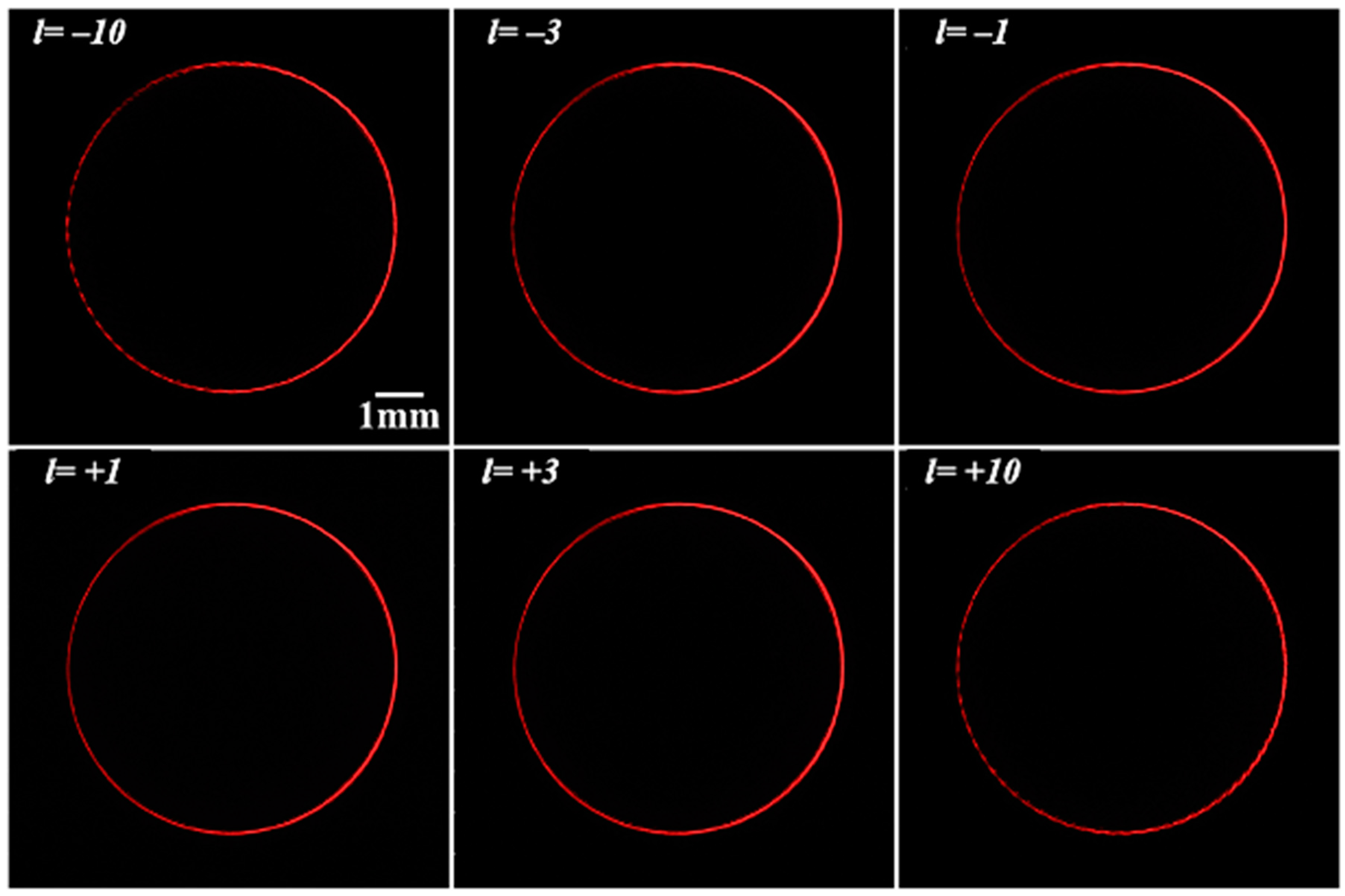
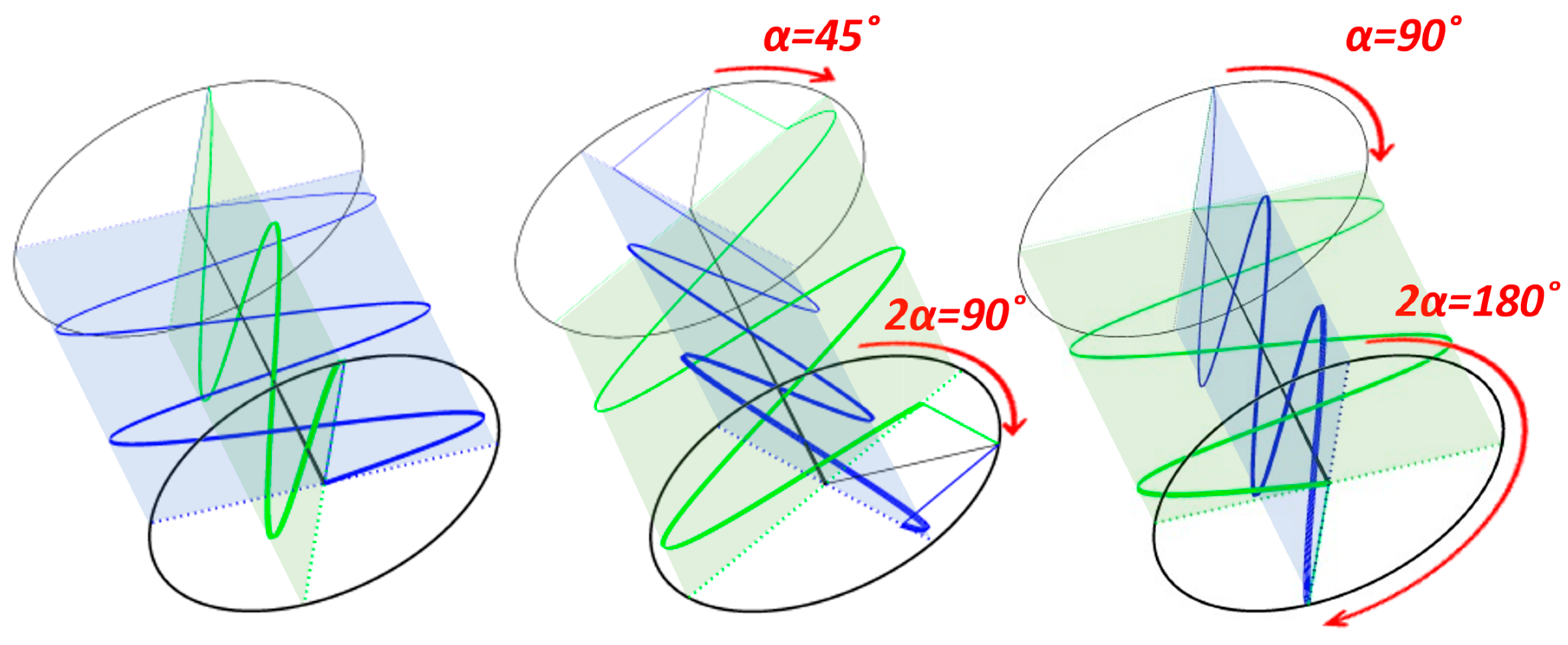

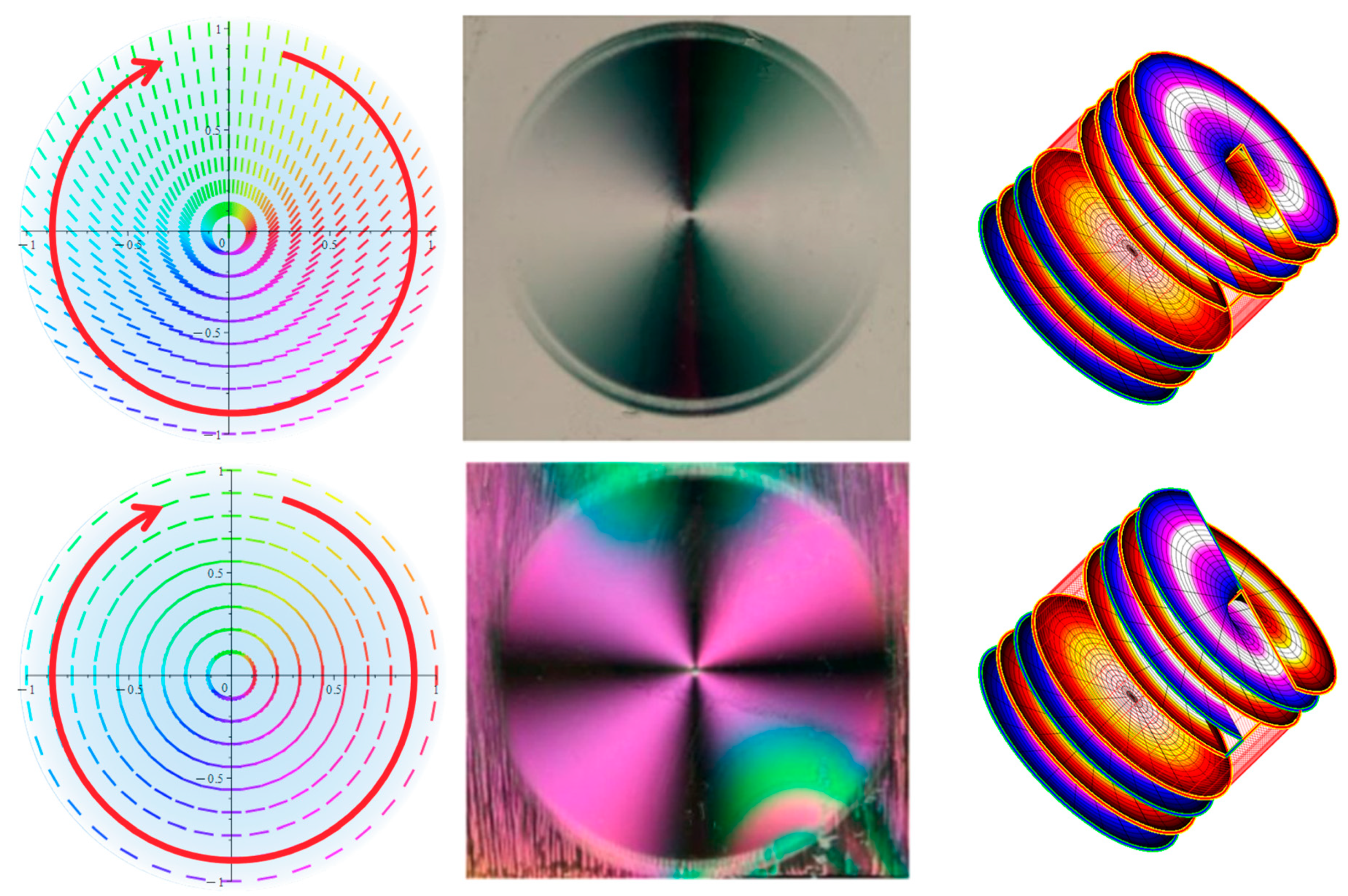


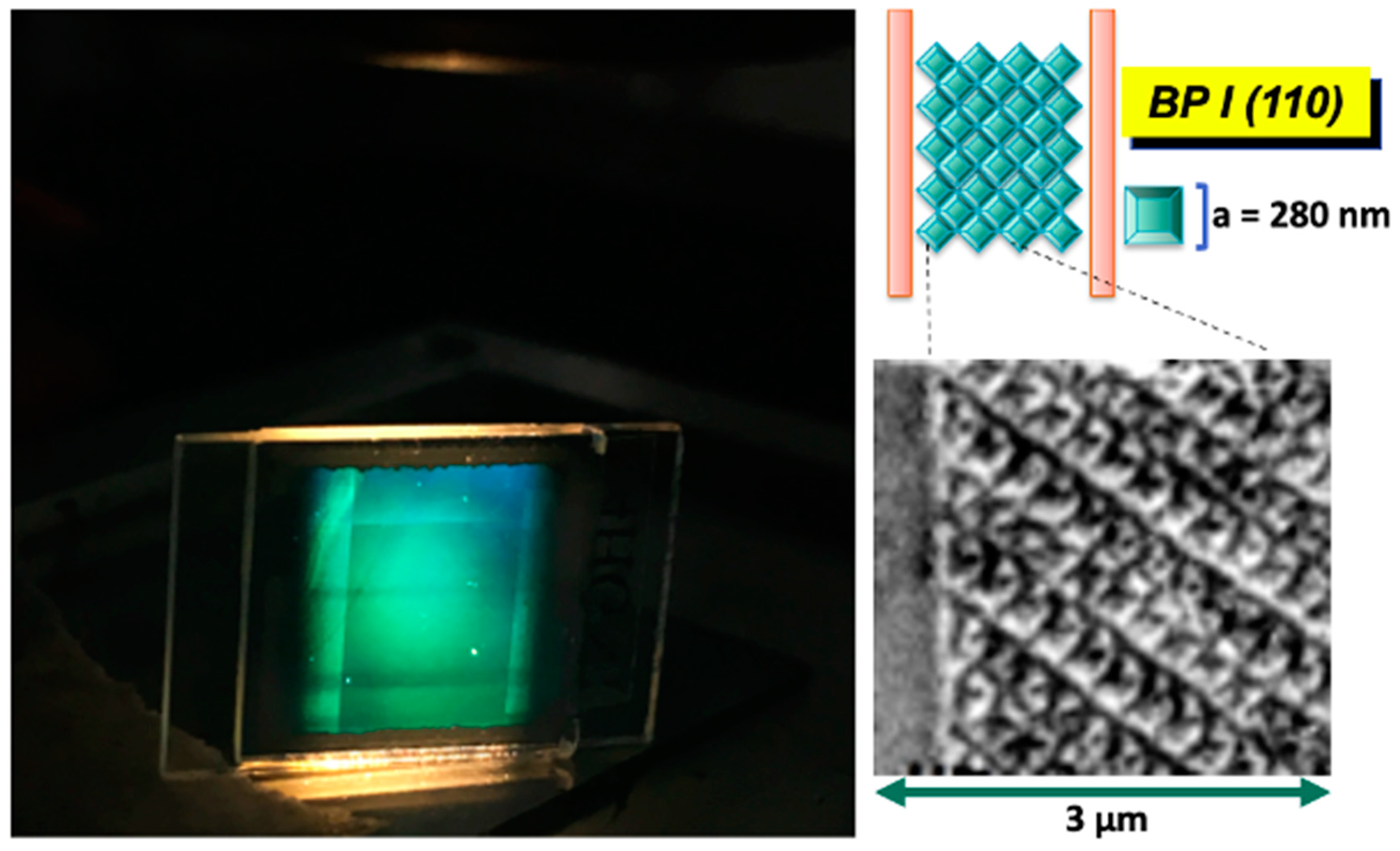



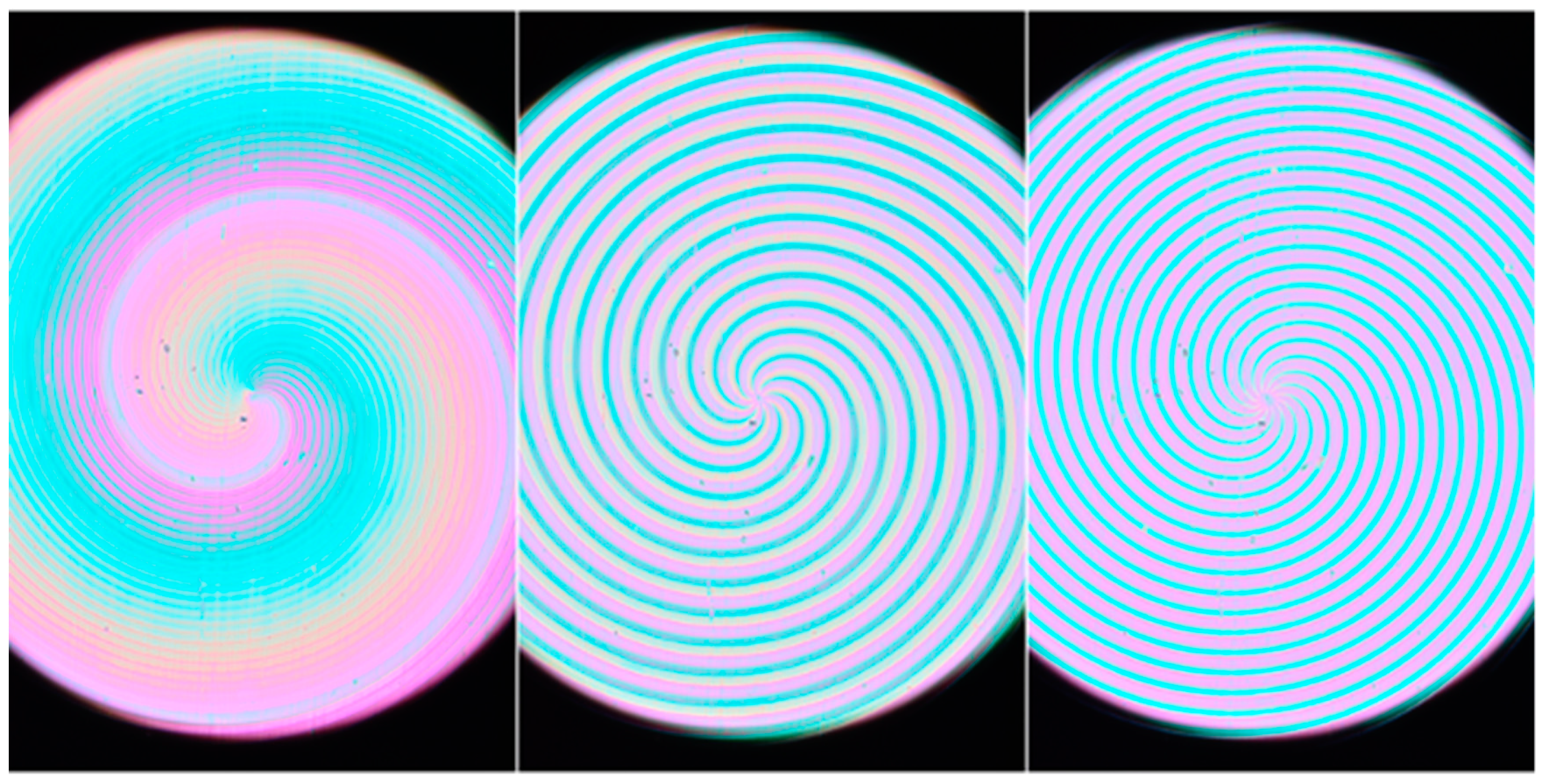
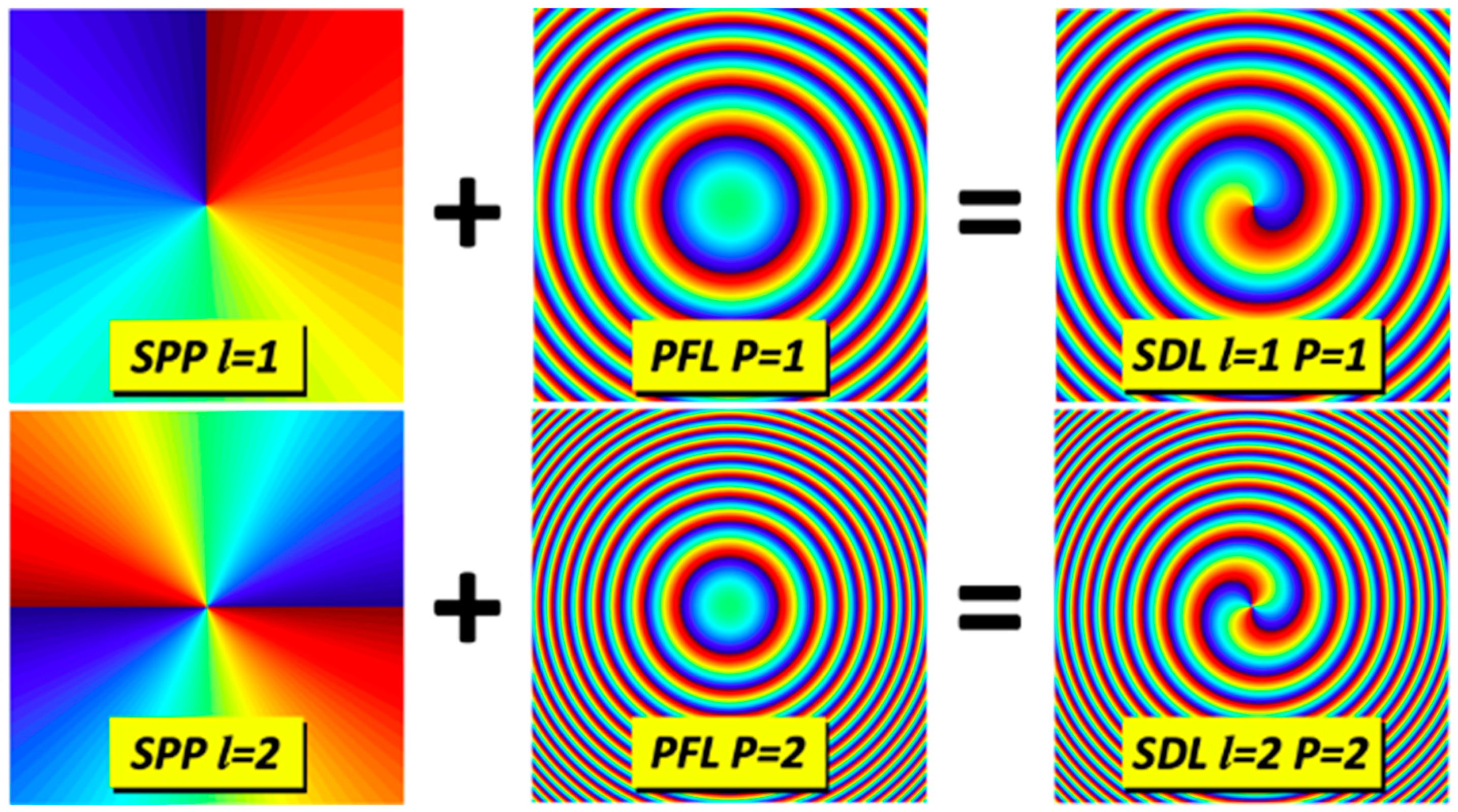
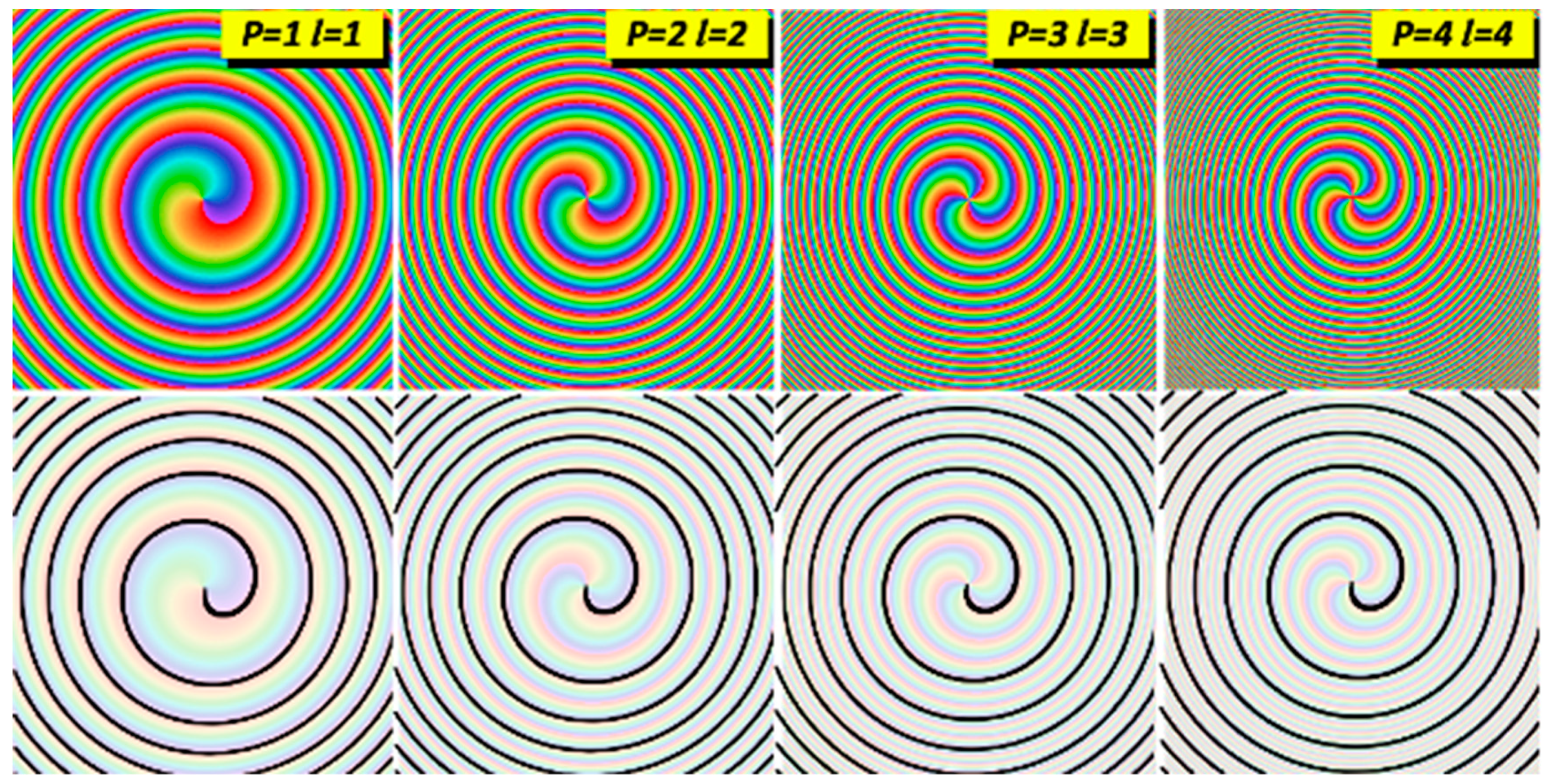
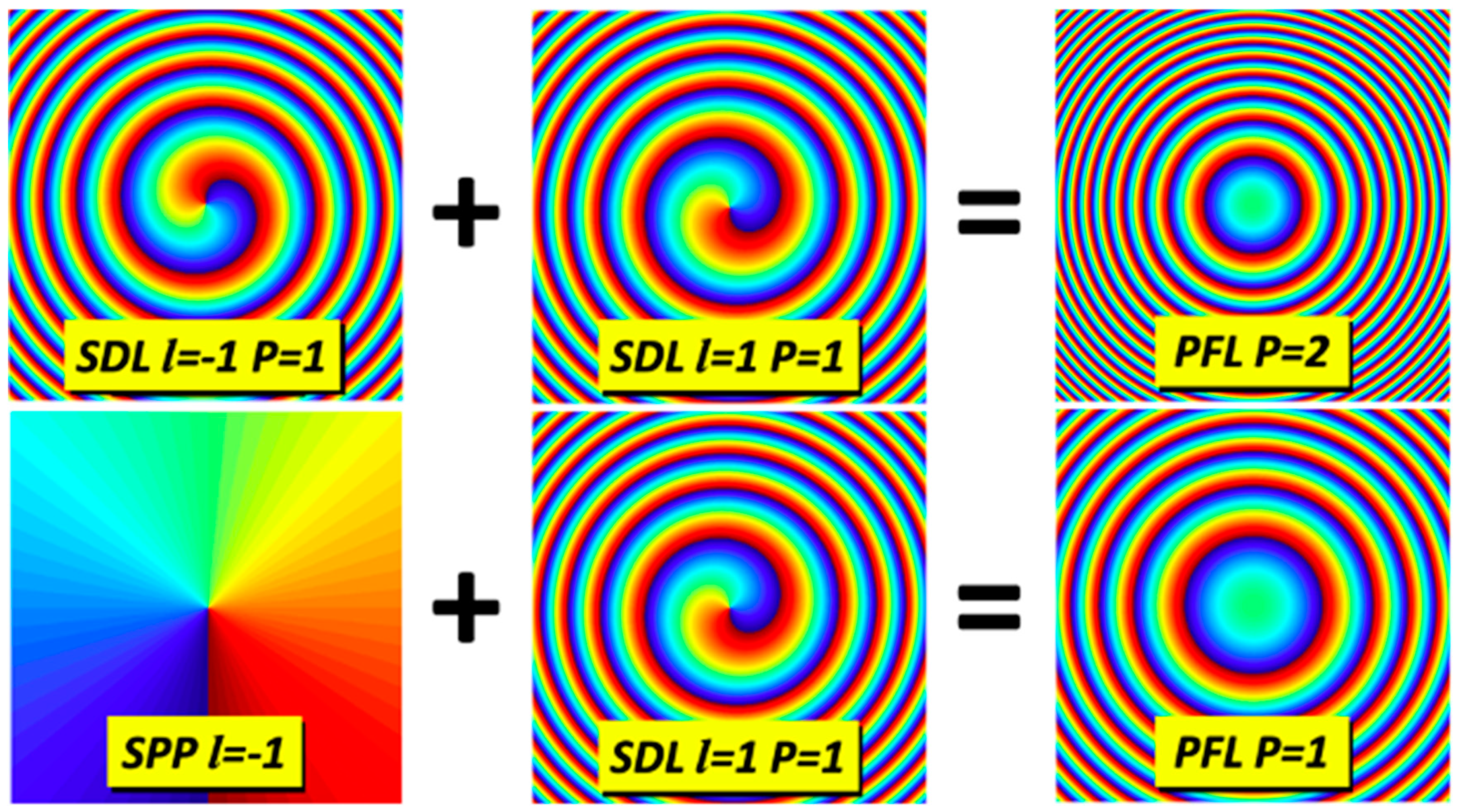

Disclaimer/Publisher’s Note: The statements, opinions and data contained in all publications are solely those of the individual author(s) and contributor(s) and not of MDPI and/or the editor(s). MDPI and/or the editor(s) disclaim responsibility for any injury to people or property resulting from any ideas, methods, instructions or products referred to in the content. |
© 2023 by the authors. Licensee MDPI, Basel, Switzerland. This article is an open access article distributed under the terms and conditions of the Creative Commons Attribution (CC BY) license (https://creativecommons.org/licenses/by/4.0/).
Share and Cite
Otón, J.M.; Pereiro-García, J.; Quintana, X.; Caño-García, M.; Otón, E.; Geday, M.A. Optimizing Tunable LC Devices with Twisted Light. Crystals 2024, 14, 16. https://doi.org/10.3390/cryst14010016
Otón JM, Pereiro-García J, Quintana X, Caño-García M, Otón E, Geday MA. Optimizing Tunable LC Devices with Twisted Light. Crystals. 2024; 14(1):16. https://doi.org/10.3390/cryst14010016
Chicago/Turabian StyleOtón, José M., Javier Pereiro-García, Xabier Quintana, Manuel Caño-García, Eva Otón, and Morten A. Geday. 2024. "Optimizing Tunable LC Devices with Twisted Light" Crystals 14, no. 1: 16. https://doi.org/10.3390/cryst14010016
APA StyleOtón, J. M., Pereiro-García, J., Quintana, X., Caño-García, M., Otón, E., & Geday, M. A. (2024). Optimizing Tunable LC Devices with Twisted Light. Crystals, 14(1), 16. https://doi.org/10.3390/cryst14010016







